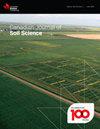开发基于土壤质地的评分功能以评估加拿大魁北克省的农业土壤健康
IF 1.5
4区 农林科学
Q4 SOIL SCIENCE
引用次数: 0
摘要
采用土壤健康指标来获取物理、生物和化学特性涉及到使用评分函数对特定区域的解释进行调整。因此,我们使用了1166个土壤样本提供的数据,这些样本分布在加拿大魁北克省农业区收集的细、中、粗质地土壤中,并分析了15个土壤健康指标。根据质地组获得的每个土壤健康指标的平均值和标准差计算评分函数。使用了三种评分类型:“越多越好”、“越少越好”和“最佳”。结果表明,除了湿集料稳定性、表面硬度(0-15cm)的渗透阻力和pH值外,有12个指标受到土壤质地的显著影响,需要单独的评分函数。这导致每个土壤健康指标都有一到三个评分函数。还调查了土壤健康指标之间的相关性分析,以更好地了解土壤物理、生物和化学性质之间的关系。我们观察到,土壤生物指标之间存在中度到强烈的相关性(r=0.59-0.74),与土壤物理指标之间存在相关性(r=0.60-0.76)。总体而言,本研究的结果导致了基于土壤质地的新评分函数的发展,以客观准确地解释土壤健康指标,造福魁北克农民和农业利益相关者。这项研究的结果表明,在解释土壤健康指标时,有必要调整评分函数,以更好地考虑区域因素对农业土壤的影响。本文章由计算机程序翻译,如有差异,请以英文原文为准。
Developing scoring functions based on soil texture to assess agricultural soil health in Quebec, Canada
Adoption of soil health indicators to access physical, biological, and chemical properties involves adapting their interpretation for a specific region using scoring functions. Accordingly, we used data provided from 1166 soil samples distributed between fine, medium, and coarse-textured soils collected in agricultural areas across the province of Quebec, Canada, and analyzed for 15 soil health indicators. Scoring functions were calculated according to the means and standard deviations obtained for each soil health indicator by textural group. Three scoring types were used: “more-is-better”, “less-is-better”, and “optimum is best”. The results showed that 12 indicators were significantly influenced by soil texture and need separate scoring functions, except for wet aggregate stability, penetration resistance of the surface hardness (0-15 cm) and pH. This led to the development of one to three scoring functions for each soil health indicator. Correlation analysis between soil health indicators was also investigated to better understand relationships between soil physical, biological, and chemical properties. We observed that soil biological indicators were moderately to strongly correlated with each other (r = 0.59-0.74) and with soil physical indicators (r = 0.60-0.76). Overall, the results of this study led to the development of new scoring functions based on soil texture to interpret soil health indicators objectively and accurately for the benefit of Quebec farmers and agricultural stakeholders. The findings of this study demonstrated the need to adapt scoring functions to better account for the impact of regional factors on agricultural soils for the interpretation of soil health indicators.
求助全文
通过发布文献求助,成功后即可免费获取论文全文。
去求助
来源期刊

Canadian Journal of Soil Science
农林科学-土壤科学
CiteScore
2.90
自引率
11.80%
发文量
73
审稿时长
6.0 months
期刊介绍:
The Canadian Journal of Soil Science is an international peer-reviewed journal published in cooperation with the Canadian Society of Soil Science. The journal publishes original research on the use, management, structure and development of soils and draws from the disciplines of soil science, agrometeorology, ecology, agricultural engineering, environmental science, hydrology, forestry, geology, geography and climatology. Research is published in a number of topic sections including: agrometeorology; ecology, biological processes and plant interactions; composition and chemical processes; physical processes and interfaces; genesis, landscape processes and relationships; contamination and environmental stewardship; and management for agricultural, forestry and urban uses.
 求助内容:
求助内容: 应助结果提醒方式:
应助结果提醒方式:


